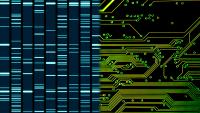Discussion Questions
1. Give examples of everyday problems that can be solved by an algorithm. What are the possible operations?
For any problem, there are multiple possible algorithms. The point of this discussion is for the students to recognize that there might be distinct solutions and to analyze their solutions.
2. The Human Genome Project has a database with the reference DNA sequence with approximately 3 billion letters (A, C, G, T). Your genome will be different from this reference DNA by, say, 0.1% or 3 million letters. If you know your genome sequence and the reference genome sequence, discuss how you might find all the differences. Remember, there are 3 billion letters to consider.
The simplest answer is to, say, let a computer look at the first letter of the reference genome and the first letter of your genome, and see if they are the same or different. Then, let the computer go to the next letter and repeat. Computers are good at doing this kind of thing automatically; they should zip through the 3 billion letters without too many problems. For more sophisticated students, the differences consist of not only differences in letters but dropouts of some letters and insertion of new letters---these are called “indel mutations.” If there are indel differences, the problem of comparison is much harder because you cannot compare the first letter of the reference to the first letter of your genome, and so on. Consider these two sentences:
This is a sentence
Tis is a sentence
It is clear you cannot compare letter by letter. Students might be encouraged to think about what to do.



 Discovering the Genome
Discovering the Genome